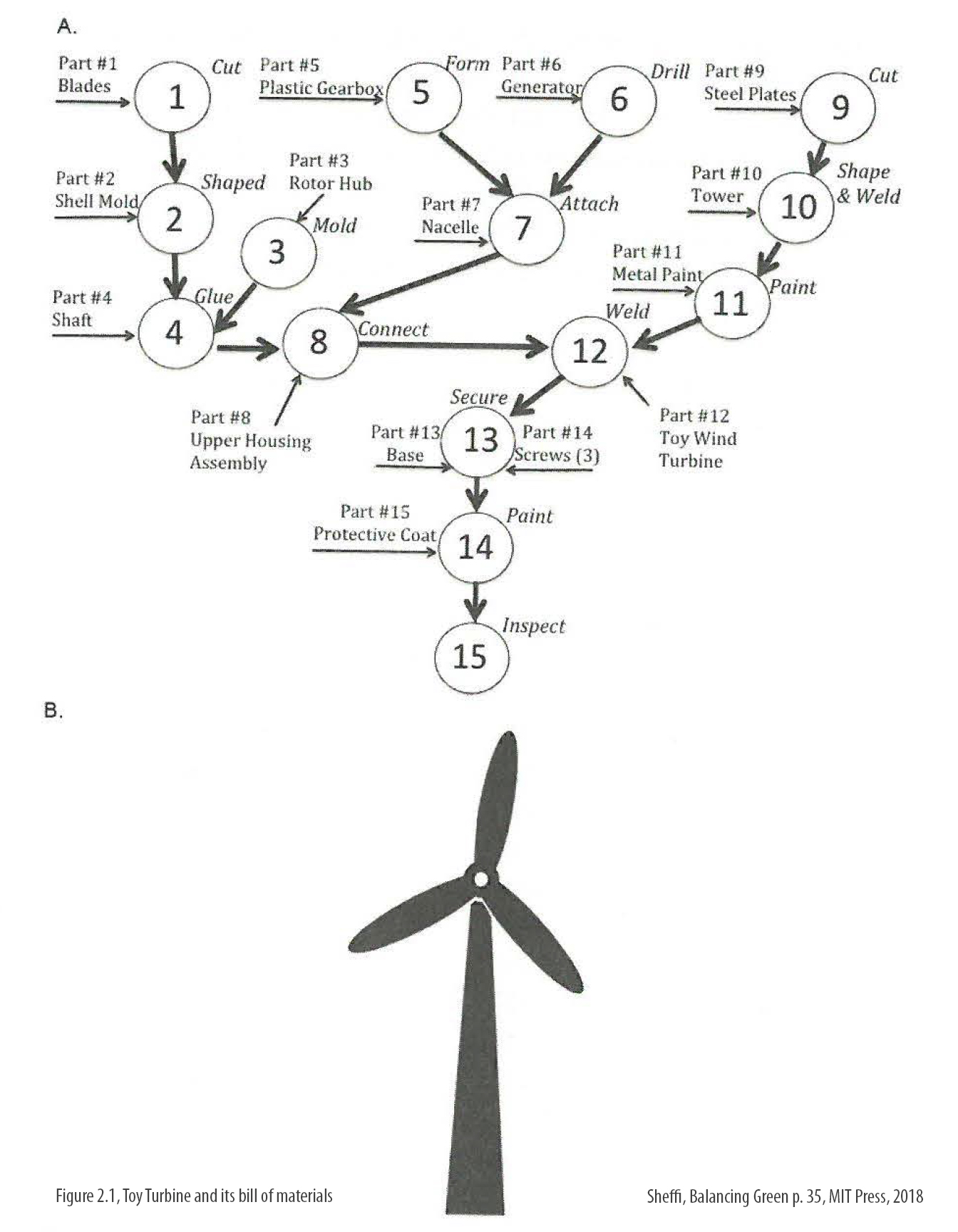Making a Product, Making an Impact
Much of the environmental impact of any product depends both on what it is made of, and on how it is made. The "Make" process is the step in which a product's constituent parts are converted into finished goods via a series of manufacturing operations.
Excerpt from "Balancing Green - (When to Embrace Sustainability and When Not To)", MIT Press, 2018
Exploding the BOM
Imagine a small, toy wind turbine-the child's version of the massive wind turbines such as those built by Siemens that are sprouting across the landscapes in many countries. The first step in understanding the environmental impact of making this toy is to analyze its bill of materials (BOM), which lists all the parts and the quantities of those parts required to manufacture a unit of the product. The BOM also includes information about how the parts relate to each other in terms of assemblies and subassemblies. Figure 2.1 depicts a 15-step process map with the 15 numbered parts listed in the toy's BOM and the respective manufacturing processes required to make the toy. Each part in the BOM is made using material, energy, and water; the process may also involve waste and emissions, thus accruing environmental impacts. A company's own manufacturing processes that make and assemble parts into a finished product will add to the total impact s accumulated along the supply chain.
This toy wind turbine has three major assemblies: the blade assembly, the nacelle assembly (the top portion that connects the tower to the blades), and the tower assembly. Workers start by making the three wooden blades (Part 1), which they first cut to the right size (Process 1) and then shape (Process 2) into shell molds (Part 2). They mold the rotor hub (Part 3) and combine the hub, blades, and shaft (Part 4) to make the blade assembly. A second group of workers creates the nacelle assembly by forming the plastic gearbox (Part 5), drilling mounting holes in the generator (Part 6), and attaching the parts together. They then combine the blade assembly and nacelle (Part 7) to create the upper housing assembly (Part 8).
Meanwhile, a third group of workers builds the tiny tower for the toy by cutting steel plates (Part 9), welding them together into the tower (Part 10), and applying a coat of metal paint (Part 11). They weld the upper housing to the top of the tower to make the toy (Part 12). Finally, they use three screws (Part 14) to secure the toy to its base (Part 13). A final protective coating of more paint (Part 15) produces the completed toy, which inspectors then check for quality.

Indirect Materials and Impacts
In theory, the BOM lists all the parts and materials bought from suppliers or made within the factory that go into a product. Yet BOMs actually leave out many of the incidental materials consumed or handled during the process of making a product. These indirect materials include an array of manufacturing consumables such as lubricants, solvents, cleansers, filters, and other materials that lurk in the factory's supply closet and are used in making product s, even if the products are not made from these supplies.
From an environmental perspective, the two biggest categories of materials not listed in a BOM are energy and water. Manufacturing processes consume electricity for machinery, lighting, heating, and cooling. Some processes may consume fuels, such as the acetylene gas used to flame-cut the wind turbine tower parts, natural gas to generate hot water, or propane to power the factory's forklifts. The factory might use many gallons of water to wash parts, chemically treat parts, or cool industrial processes. Thus, the BOM gives only a partial basis for calculating the environmental impact s of manufacturing.
Although it implicitly specifies a unit of output of the finished product, it does not document other manufacturing outputs. Each item of the BOM, as well as indirect materials, might come with greenhouse gas (GHG) emissions, wastewater, and other by-products. Some manufacturing steps, such as painting or gluing, may give off toxic or smog-inducing vapors.